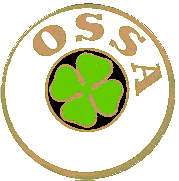2008-november-11
Hi Mats, Now I finished a 175 SE road model from 1965. Not as an original,
but a 'personal version' with another gastank (a one of an early 230 Sport)
and another frontfork (a one of an Enduro-model - don 't no which one exactly).
The engine is overbored to 64 mm and has the original 60 mm stroke.
Piston is from a Yamaha R 5, conrod from a Cagiva. 200 cc, nearly
22 hp at 7200 rpm, 28 AMAL Concentric carb. Tires 3.00x18, rims 1.85 x
18 italian Akront-replica, brakes original simplex 158 x 40 mm.
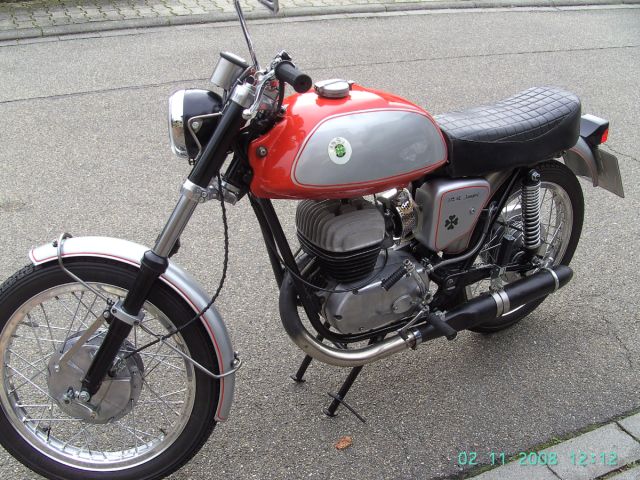
Regards - Harald
2004-december-14
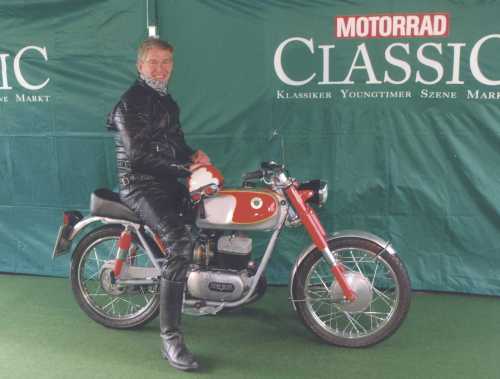 In early summer 2002 I got an information in EBAY that a privat dealer
sold two OSSA street-version bikes. Nothing else was known by the
dealer, because both bikes were full of dirt and not in good shape.
In early summer 2002 I got an information in EBAY that a privat dealer
sold two OSSA street-version bikes. Nothing else was known by the
dealer, because both bikes were full of dirt and not in good shape.
Although one of the bikes was ridden down heavily and the other was
badly damaged, I could not resist: I must have these bikes and finally
I bought them for an "apple and an egg". At home I noticed , that the first
one was a 160 T from 1964 and the second a 175 SE from 1965. In my
opinion, both these bikes were the only street version - OSSAs, which were
offered in the last years in Germany.
I decided, to make "one out of two" and in late summer 2002 I began
with the restauration.
First of all I disassembled both bikes completely. For this, I
had to rebuild the special OSSA-tool-kit first; because there is no chance
to disassamble the cush drive and the clutch without these tools.
By cleaning the parts, I could see that the 160-motor and the
frame would not be the great problem. But: the frontfork, the gastank
an some details showed me at the beginning that it would take a long time
to finish the work.
| I started rebuild the bike with the 160-engine. Cylinder barrell ,
piston and crankshaft were in not good, but useful condition, also the
gearbox, the shafts and the 4 gear-wheels. So I had only to
install new bear- and sealrings. This was not a problem: all parts are
standard-parts ( 6205 for the crankshaft and 6303 for the mainshaft ).
After cleaning, nearly all the parts were able to use. The piston had
a little mark of pressing with the liner on the exhaust side, but after
ten minutes of polishing the problem was over.
It takes also only a little time to polish both sidecases and to colour
the cylinder barrell in black. That was it. I gave the kickstarter and
the gear-shifter to a specialist for croming the parts. The exhaust had
al lot of bumps, but this was also not a problem. I took a new stuff
( “Kaltmetall” – aluminium powder with special epoxid ) an filled all the
bumps . At last I coloured the pipe in the original black.
|
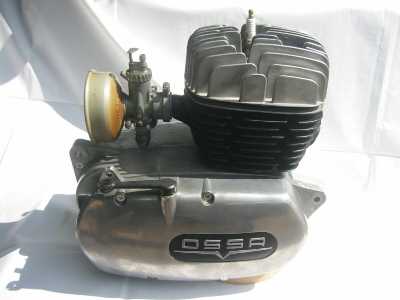 |
The rebuilding of the frame took more time that it should have. Especially
the grind of the 40 years old colour took very long time. To give
more stiffness to the frame, I melted two tubes between the central
and both sidetubes and a third one 2 cm above the rocker (as the later
175 SE had ).
I decided to colour the frame in "OSSA-silver", although I knew, that
the original 160 T had a black one. ( I prefer the silver-red looking 175
SE from the late sixties).
After this act the "times of the details" began. I had to buy tires,
rims, a new headlamp,6 Volt bulbs ( 15/15 watts), and new, cromed spokes.
A little problem were the brake-shoes. First it seems, that the old one
would be o.k., but they weren't. I had to order new ones by an German special
firm, and so the rebuilding of the four shoes became rather expensive.
The latest part was the ignition. I could use nearly all parts of the
magneto-side and had really only a little work to install the correct
ignition point ( 3 mm BTDC ).
| In July 2004, the "ceremony" started: Gas in the tank, carburettor
tipped for 6 seconds, one kick on the starter and - my "senorita" made
the first "räng däng däng" in her new outfit.
And now, after nearly 300 km of testing the bike, I have to fight with
some little problems, which present me some bad moments of surprise. The
ignition-coil inside the flywheel is very o.k., but the light-coil is either
in bad condition or overloaded. By using the horn, the headlamp collapses,
also by using the rear brake. To solve away this problem, I think that
I must install a double light-coil ( one of them only for horn and rear
brake ( as the German 50 cc-bikes of the 70's had ).
A second problem is - still - the rear brake. Because I used the frame
of the 160-model with the rear-brake of the 175 SE, I had to change the
mechanism from handle to bowdencable. And this transmission must
be the source of failure. So I have to install another kind of lever to
use a more shorten cable.
|
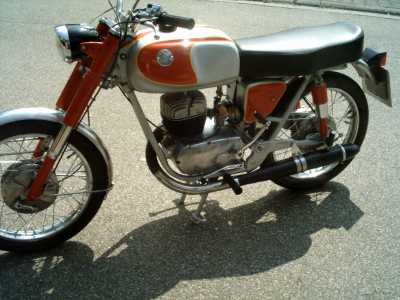 |
| After this trouble-shooting of the actual 160 -version, I like to rebuild
the "big" engine this winter. I think, it will give me much more challenge
than the little engine did. Nearly all the parts are badly damaged, both
crankcase-sides in a very bad shape (on the outsides) . The alloy is bad
looking and shows many proofs of stone bruises and badly used tools.
A lot of polish working waits for me.
Very expensive was the repair of the crank with con-rod and the cylinder
barrell. The complete part was rusty, the bearings broken. The only help
was a radical repair by a specialist. He disassembled the whole crank,
installed a new cagiva type con-rod, two new needle-bearings and
a new crankshaft journal. Now I can use a piston of a 400 cc
two-cylinder Yamaha, so as a result I'll have a 200 cc OSSA with
perhaps 19 bhp. For this, I had to install a new liner in the bored-out
alloy-barrell. The biggest problem here was (and is) the setting of the
four channels in the exact position.
Here I had to make a cut, because this is the actual result of rebuilding
my OSSAs - and I'll see, what surprises are waiting for me
this winter.
Harald Kurzer,Rauenberg, Germany
phone: +496222/660796 |
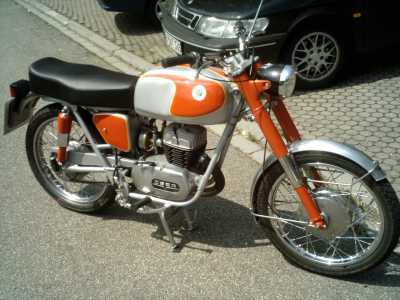 |
